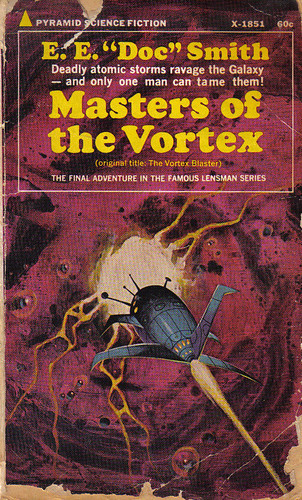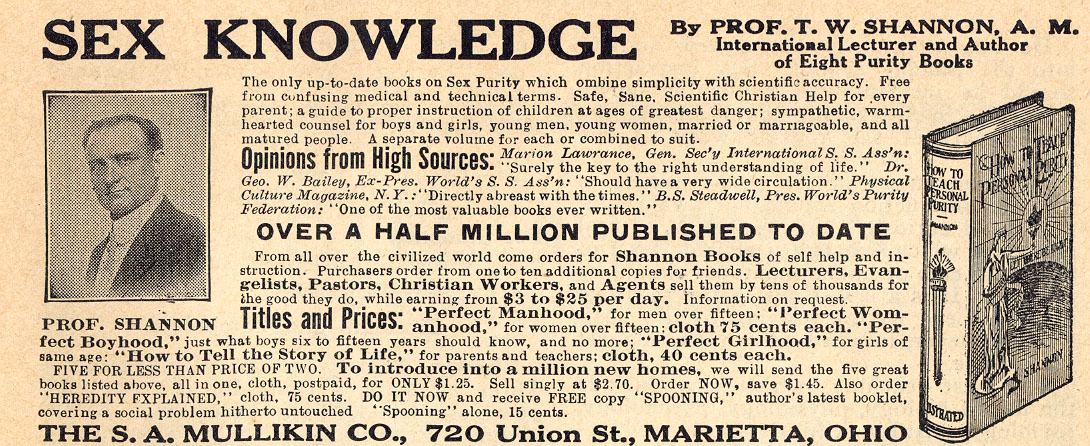Thursday, January 31, 2008
"Directly abreast with the times."
From the Boy Crusader’s Pledge (1914):
Young Man, Keep Clean Inside
The man or boy who pollutes society with unclean speech or vulgar story should be branded as a criminal, for criminal that thing is. The filthy suggestiveness of an improper story will soak into the memory as spilled ink soaks into blotting paper. Allow no man to drag your mind through a sewer. Keep your mind sullied. It is of more importance to keep the dirt off the soul than to keep it off the clothes.
See more exciting ads from the backs of early 20th century missionary magazines here!
Wednesday, January 30, 2008
Saturday, January 26, 2008
Quarantine
 I just finished reading Quarantine by Jim Crace (1997) as part of the infamous Smarter Than You Bookclub. This book takes place 2000 years ago or so in a little land called Judea. Five pilgrims have come out into the desert for 40 days of fasting: Marta, a barren wife hoping to give birth to a child; Aphas, an old man hoping to have his cancer cured; Shim, a proud scholar hoping to prove his connection to god; Badu, a deaf-mute guy that we really don't learn much about (except that he is a good hunter); and a young man from Galilee that you might have heard of -- Jesus. These pilgrims stumble onto the temporary camp of Musa, a traveling merchant, and his pregnant wife, Miri. Musa has a horrible fever and the two have been abandoned by their caravan.
I just finished reading Quarantine by Jim Crace (1997) as part of the infamous Smarter Than You Bookclub. This book takes place 2000 years ago or so in a little land called Judea. Five pilgrims have come out into the desert for 40 days of fasting: Marta, a barren wife hoping to give birth to a child; Aphas, an old man hoping to have his cancer cured; Shim, a proud scholar hoping to prove his connection to god; Badu, a deaf-mute guy that we really don't learn much about (except that he is a good hunter); and a young man from Galilee that you might have heard of -- Jesus. These pilgrims stumble onto the temporary camp of Musa, a traveling merchant, and his pregnant wife, Miri. Musa has a horrible fever and the two have been abandoned by their caravan.After an off-hand, and rather accidental, curing of his fever by Jesus, Musa sees an opportunity to make some money from the pilgrims by charging them rent and selling them food and water when they break their fast at dusk. Miri is not that happy about Musa being cured, since he is a major jerk and she thought she was finally free of him. All the pilgrims fast together except for Jesus, who finds his way into an inaccessible cave where he refuses to speak to the other pilgrims, heal anyone else, or accept any of the food.
 The conflicts between the pilgrims and the merchant, and their differing personalities, make for a very engaging and fast-paced story. You might have some idea of how things turn out with Jesus, although the way in which his fast concludes is a little more interesting than you might expect.
The conflicts between the pilgrims and the merchant, and their differing personalities, make for a very engaging and fast-paced story. You might have some idea of how things turn out with Jesus, although the way in which his fast concludes is a little more interesting than you might expect.The basis for Crace's novel comes from a brief discussion of the temptation of Christ in the desert during his 40 day fast (mentioned in Matthew, Mark, and Luke). I'm not religious at all, and certainly no biblical scholar, but I like what Crace did with the story of Jesus and his fast. I think a theologian would have a lot of fun with this novel, and that people with a casual (or even anti-) interest in Jesus would enjoy it as well. Our fictional Jesus is more human than divine -- alternatively doubtful and proud, both sympathetic and off-putting, and a skinny daydreamer who has to pee a lot but holds it in sometimes as a sacrifice to god. I probably have more to say, but I'll save it for the bookclub.
[Do any of you STYBCers want to borrow my copy?]
Thursday, January 24, 2008
Nerd Alert
Right now it is 43 degrees Fahrenheit outside with 43% humidity, and this makes me super happy. Even more happy than when I look at the clock right at 11:11.
Wednesday, January 23, 2008
StuPd
Along the same lines of the buzzings pet peeve: why would a financial institution with a nice, solid name like Washington Mutual decide to change its name to the dumb sounding WaMu? I can't even say WaMu without sounding like an asshole. Is that what Washington Mutual wants from us? Do they think we can't remember two words so instead they'll just give us two syllables?
Luckily I bank at the totally solid credit union, so I don't have to worry about abbreviations -- just nice friendly acronyms like UFCU.
Luckily I bank at the totally solid credit union, so I don't have to worry about abbreviations -- just nice friendly acronyms like UFCU.
Monday, January 21, 2008
Kitchen Confidential or a Big Welcome to Secret Boyfriend #51
 Oh Anthony Bourdain, you are such a sexy bad-boy chef. You deserve your place on the mantel of Secret Boyfriendom, even though my weekly excursion to SB-land has stopped. Welcome to the club...
Oh Anthony Bourdain, you are such a sexy bad-boy chef. You deserve your place on the mantel of Secret Boyfriendom, even though my weekly excursion to SB-land has stopped. Welcome to the club...And thanks to two awesome dudes, Dr. M and I received a copy of the book that brought you to the public eye, your memoir and insider's look at the professional kitchen -- Kitchen Confidential: Adventures in the Culinary Underbelly (2000).
This book is as sexy and fun to read as the adventurous and charismatic Bourdain is to watch. He takes us on a tour of his career, from his first job washing dishes in Cape Cod and his stint at the Culinary Institute of America, to a never-ending series of rises and falls through a variety of high and low-end chef jobs -- nameless restaurants that failed, and named restaurants that went on to succeed without him. Along the way, we get a look at what it is that a professional chef does with his day: how orders are procured, how the line works, how staff is handled, and how specials are thought up. Most of all, we share Bourdain's infectious love of good food, dismissal of pretentiousness, and the difficult but rewarding life of a professional chef.
 In the end, we merge with Bourdain as the executive chef of Brasserie Les Halles in New York, and then send him off to his impending career as celebrity food raconteur and TV personality. And of course, his greatest honor of all: a place on the Spacebeer Secret Boyfriend Hall of fame.
In the end, we merge with Bourdain as the executive chef of Brasserie Les Halles in New York, and then send him off to his impending career as celebrity food raconteur and TV personality. And of course, his greatest honor of all: a place on the Spacebeer Secret Boyfriend Hall of fame.
Thursday, January 17, 2008
On Flocking to a Fire, circa 1928
 Some helpful advice from the front page of the Bryan Daily Eagle, August 28, 1928:
Some helpful advice from the front page of the Bryan Daily Eagle, August 28, 1928:The People’s Column
Attention of our people has been called to the ordinance which forbids automobiles from rushing to fires when the alarm is sounded and to park in the proximity of the blaze. This may seem like a needless restriction at first glance, but it is of utmost importance. In many instances the sparks will fly around and might take such a turn that the presence of spectators would hamper the fire boys in extinguishing the flames. Flocking to a fire is really a “Hick-town” custom that has about passed out with the advent of the radio and other new discoveries. If spectators could do any good at the fires the humanitarian appeal would be strong, but in reality they only hinder and never help. Let’s observe this law.
And an unrelated headline, also on the front page: “Murder Orgy is Blamed to Insane Man”
Sadly the accompanying story was not nearly as intriguing as the headline...
Tuesday, January 15, 2008
Masters of the Vortex
 Aw shit, I finished the Lensman series last year! But what if I still want to read about the Lensman universe? What's a girl to do?
Aw shit, I finished the Lensman series last year! But what if I still want to read about the Lensman universe? What's a girl to do?Why she just picks up a handy copy of E. E. "Doc" Smith's Masters of the Vortex, another action-packed tale set in the universe of the Lens, but without Kim Kinnison and our other favorites from the series (thanks, once again, to the lovely Choo for the book loan). The stories were originally published in the early 40s, and the hardcover came out in 1960 (a pretty detailed description of the publication process can be found here if you're interested).
In Masters of the Vortex our hero (Neal "Storm" Cloud) actually isn't a Lensman, instead he is a nuclear engineer with an amazingly mathematical mind. Cloud's family is tragically killed in a freak accident by a "flying vortex of atomic destruction" -- one of many vortices that have been a side-effect of the wide-spread use of nuclear energy and are terrorizing planets around the universe. Devastated by the loss of his family, Cloud takes a leave of absence from the Galactic Patrol, only to be struck with an idea for "blowing out" a vortex and stopping its path of destruction. It is rather technical (and Smith is soooo good at writing the technical stuff in a fun way), but the general idea is that Cloud's brain works so fast that he can calculate exactly where the center of the vortex will be at a moment in time and then hit it with a bomb that is set at the exact strength to dissipate the charge and save the world.
As you might expect, this works, and it makes Cloud a very popular guy.
Cloud's new job as the universe's one and only vortex blaster takes him from planet to planet where he and his (totally awesome) crew (of aliens) battle wits against drug dealers and freaky life forms, and where his heart eventually begins to heal and his eyes turn toward his sexy, super smart, and self-taught psychic co-worker.
This book is a very fun read and stands alone from the other Lens books (so no need to read them first if you haven't already).
[And rock out with the back cover here -- Runaway Vortex!!]
Monday, January 14, 2008
Skitter, scratch, and squeak
 Dear Mice,
Dear Mice,I don't really like you in the kitchen -- in fact, you make me irritated and germ-conscious when I hear you under the fridge. What I like even less, however, is your nightly dance parties in the ceiling right above my head while I'm trying to sleep. 11 pm - 5 am might seem like a good time for running back and forth and making never-ending scratching sounds to you, but it is actually my prime sleeping window. I sincerely hope that you are trying to come up from our upstairs neighbors floor and not down through our ceiling so you can fall onto my bed, but at 3 am, when I've been up for hours, all I can think of is a mouse invasion in the bedroom. This means that, even if I do manage to slip into sleep for a bit, my dreams will not be so good. So please, for the sake of my sanity, have your party somewhere else. I'm sure our neighbors won't mind.
Best,
SB
Saturday, January 12, 2008
I wish I had a Tik-Tok...
 I know I sort of posted about this before, but I just watched Return to Oz (d. Walter Murch, 1985) for the first time since I was a kid and I'm all giddy about it.
I know I sort of posted about this before, but I just watched Return to Oz (d. Walter Murch, 1985) for the first time since I was a kid and I'm all giddy about it.Every one of the millions of people who love the Wizard of Oz should see this movie. It didn't do well when it was released because most people were expecting it to be a straight sequel to the Judy Garland movie. Instead, Murch gives us a film that is much darker, closer to the original books, and much more like one of the original Grimm's fairy tales than the beautiful story book of the earlier film. The special effects hold up wonderfully -- all puppets and animatronics, some done by Jim Henson's son Brian. They have a warmth and character to them that can't be replicated by CGI. I don't think I'm just being nostalgic here...
One of the best characters in the film is Tik-Tok, the mechanical man who talks with his moustache, has to be wound up constantly, and defends Dorothy with every ounce of his mechanical mind and body. He is simultaneously hilarious, brave, and really sweet. I really do wish I had a Tik-Tok of my own.
One of the reasons I liked this movie so much as a child, and why I think it is still a great film for children today is that Dorothy gets into truly dangerous and scary situations, and through her own power and the support of her goofy group of followers, she solves problems and rescues herself. Plus it is fun to get freaked out when you are a kid. Actually, it is still fun to get freaked out as an adult...
Little Kristy thought this was one of the freakiest scenes in the movie (excepting, of course, those super-freaky Wheelers):
Seriously, rent this at your next opportunity. And buy it for all the young boys and girls in your life. You won't be disappointed.
[If you are interested in seeing how all the puppets and robots work, check out this twenty minute behind the scenes documentary made on the set -- the dude who had to fold himself in half to play Tik-Tok must have had some major dedication...]
Thursday, January 10, 2008
Middlesex
 Thanks to the lovely Joolie, I wrapped myself around Middlesex (2002) by Jeffrey Eugenides over my holiday break. Seeing as it is a Pulitzer prize winning novel, it really isn't any surprise that it was very good. And, if you are like me, you might think of not reading it since Oprah made it a bookclub choice. But resist those thoughts! Join the masses! Because Middlesex is really quite a nice read.
Thanks to the lovely Joolie, I wrapped myself around Middlesex (2002) by Jeffrey Eugenides over my holiday break. Seeing as it is a Pulitzer prize winning novel, it really isn't any surprise that it was very good. And, if you are like me, you might think of not reading it since Oprah made it a bookclub choice. But resist those thoughts! Join the masses! Because Middlesex is really quite a nice read.The book follows the story of Cal, who is an intersex man who grew up as a girl, Calliope. We find this out at the beginning of the novel, but (in a very Tristram Shandy-like way), we then go waaaaay back to Cal's ancestral village on the slopes of Mount Olympus where his grandmother and grandfather are dealing with the death of their parents, coming of age, and getting forced out of their village by invading Turks. The novel traces the story of the hermaphroditic gene that has affected the village for years -- one in which a baby that looks outwardly like a girl begins to manifest male characteristics when she hits puberty. And due to the breaking of a taboo, a dose of chance, and the general mystery of genetics (and through nearly half the book), we follow the grandparents to America, and follow their genes into Calliope.
I liked the family-history part of the story -- Eugenides gives Cal a fun omniscience that gives the narration a unique perspective. But where the book really gets going is when Calliope hits puberty. The particularly involving part (for me at least) is how much I related to her feelings during this universally awkward time. I know I felt gigantic and gawky and weird and out of control when I was 14, just like Calliope. And every adolescent feels isolated and like the things that are happening to them couldn't possibly be happening to anyone else. Of course, in Calliope's case, she is right -- most of the other girls at her private school were going through puberty, but none of them were starting to display male sexual characteristics.
The book even has a very satisfying, if bittersweet, ending. So, Middlesex = yay! Go check it out.
[And finally, doesn't Eugenides have the greatest author picture? The author picture is one of my favorite photo genres, and he does it up perfectly. ]
Tuesday, January 08, 2008
Robocam
 Meet Robocam, my new best computer friend. My sister had the inspired idea of getting everyone in my family matching robot-shaped webcams for Christmas. The lens is in his little tummy, the microphone is on his little forehead, and his little eyes light up (in actually a kind of freaky way) to brighten your face. Plus he is shaped like a robot with poseable arms and legs. Even if I never used him as a webcam, he is a pretty nice addition to the computer ensemble. So far the only person I've video-conferenced with is my dad, and we spent most of the time just laughing and waving our hands in front of the camera. It was fun for a novelty call, though, and also fun to see my dad's face, my mom popping in, and a portion of the living room.
Meet Robocam, my new best computer friend. My sister had the inspired idea of getting everyone in my family matching robot-shaped webcams for Christmas. The lens is in his little tummy, the microphone is on his little forehead, and his little eyes light up (in actually a kind of freaky way) to brighten your face. Plus he is shaped like a robot with poseable arms and legs. Even if I never used him as a webcam, he is a pretty nice addition to the computer ensemble. So far the only person I've video-conferenced with is my dad, and we spent most of the time just laughing and waving our hands in front of the camera. It was fun for a novelty call, though, and also fun to see my dad's face, my mom popping in, and a portion of the living room.Overall using my robocam makes me feel like I'm living in the future -- because isn't the future all jetpacks and video phones?
Sunday, January 06, 2008
The Story of Forgetting
 I recently received an advanced reader's copy of The Story of Forgetting the debut novel by Stefan Merrill Block (2008) through the LibraryThing Early Reviewers program (which I love love love).
I recently received an advanced reader's copy of The Story of Forgetting the debut novel by Stefan Merrill Block (2008) through the LibraryThing Early Reviewers program (which I love love love).The Story of Forgetting is an engaging and complex story that revolves around a familial genetic curse of early-onset Alzheimer's that goes undetected until the affected person is in their late-30s. When it strikes, they start forgetting the things closest to them in time and begin living their lives in reverse until, at the end, they forget to breathe, their heart forgets to beat, and they die.
The story comes together through different tracks: Abel, a 70 year old man living near Dallas in his childhood home and gradually being surrounded by suburban houses as he sells away the family farmland; and Seth, a 15 year old living in the suburbs of Austin whose mother, Jaime, is beginning to forget. Jaime never told her husband or son anything about her childhood -- she wouldn't even tell Seth her maiden name -- so when Seth finds out that the disease is genetic, he begins a quest to trace his mother's history as a way of understanding his own potential future.
Laced through these two storylines are the tales of Isidora, a family mythology about a hidden land where no one remembers anything and everyone is content in the moment. These stories are passed from generation to generation, and are one of the only hints that Jaime gives Seth about her past. The book also takes us through a scientific history of the disease, going back to the first mutated chromosome on an English Duke in the 1800s. We watch as his affairs with local women multiply (he is very discrete, since he can't remember anything) and his illegitimate children continue the legacy of the disease.
I really enjoyed this book -- the subject matter is unusual and interesting, the characters are well written, and the pacing is excellent. It almost lets me forgive Block for only being born in 1982. And since he is from Plano and the book takes place in the Austin area, Austin readers can marvel at familiar landmarks (Round Rock! MoPac! UT!). You can read more about Block and his novel at his website. And thanks to the power of Google and his unusual name, you can also read about his 1999 citation in the Intel Science Search for his research in field of deception and non-verbal expression of emotion.
[image above is a drawing of Alzheimer neuritic plaques that I found here.]
Saturday, January 05, 2008
Holiday Recap
 We have safely returned from our annual trek to Nebraska, where we didn't see the ground once in two and a half weeks since it was constantly covered with snow, snow, ice, and more snow. Come and relive the experience with me by browsing through the 327 pictures we took on the trip, chronologically arranged for your viewing pleasure.
We have safely returned from our annual trek to Nebraska, where we didn't see the ground once in two and a half weeks since it was constantly covered with snow, snow, ice, and more snow. Come and relive the experience with me by browsing through the 327 pictures we took on the trip, chronologically arranged for your viewing pleasure.Highlights include: cats (including hairless cats), dogs, snow, babies, uno, RockBand, a siblings new year's eve featuring Singstar, dance parties, sunglasses, and a return of the beeritar.
Subscribe to:
Comments (Atom)

